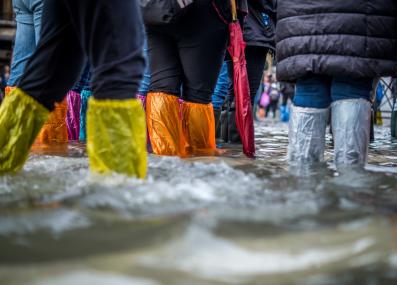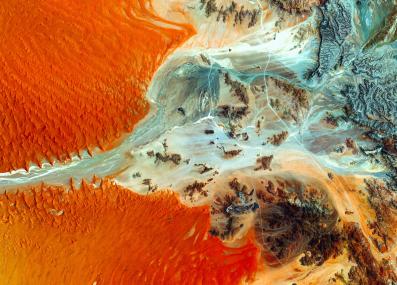Have a question?
What are the best- and worst-case scenarios for sea level rise?
By 2100, we could see as little as 8 inches of additional sea level rise, or over 6 feet—based partly on how much we continue to pollute the climate, and partly on how the oceans respond to climate change that's already baked in.
June 12, 2024
Earth’s sea level is rising as humanity warms the atmosphere and oceans by burning fossil fuels. Average sea level has risen by more than 20 centimeters (about 8 inches) since 1900, and it keeps rising faster, says Brent Minchew, an MIT geophysicist who studies glaciers and oceans.
However, he says, there is an enormous difference between the potential best- and worst-case scenarios for the future of sea level rise.
An important question is how much climate-warming greenhouse gas we continue to put in the atmosphere. In the rosiest possible future, global average sea level will rise another 20 to 50 centimeters (8 to 20 inches) by the year 2100. Minchew says the low end of that range would require humanity to achieve negative greenhouse gas emissions—in other words, not only stopping new emissions but also removing some excess greenhouse gases already in the atmosphere. The higher end, 50 cm, would occur if we did not meaningfully manage to cut our emissions, but still avoided a spike in sea levels from the collapse of major ice sheets or glaciers.
This range of sea level rise would not be cataclysmic, but it would be disruptive. Minchew says an extra 20 cm of rise would cause much more “nuisance flooding” for coastal communities, turning what used to be hundred-year floods into disasters that occur every couple of decades. Nations would need to invest vast sums in coastal infrastructure to keep floodwaters at bay, including new “green barriers” like wetlands and mangrove forests and “gray barriers” like seawalls.
The worst-case scenario, however, is much worse. Minchew says the maximum projection for sea level rise by the end of the century reaches 2 meters, or 10 times higher than the 20-cm scenario. What’s especially daunting is that halting greenhouse emissions may not be enough to stop this disastrous outcome.
“Early-stage [sea level rise] was driven primarily by warming of the atmosphere due to increased CO2,” he says. “But more and more, we see sea level rise being driven by different kinds of feedbacks within the system. Nowadays, the majority of sea level rise that we get both in Greenland and Antarctica is primarily driven by heat within the ocean—and that's not necessarily the ocean warming up directly because of ongoing climate change. It's more about shifting patterns of winds that are moving deep warm water around and causing it to come into contact with the glaciers.”
This ocean warming is especially important for Antarctica. Today, Greenland’s melting glaciers are the biggest contributor to sea level rise. But it is the fate of Antarctica’s ice, and particularly the West Antarctic Ice Sheet, that represents the tipping point between the best- and worst-case scenarios.
The eastern part of Antarctica contains most of its ice, but those ice sheets sit on stable ground. The West Antarctic Ice Sheet rests below sea level, which creates uncertainties about whether, and how quickly, it could slide into the ocean. "If we're going to get a meter or two of sea level rise by the end of the century, it has to come from West Antarctica,” Minchew says. “Given everything that we know, it cannot come from anywhere else."
Farther in the future, the differences between the best- and worst-case scenarios grow even starker. Unlike world temperatures, sea level rise responds slowly to climate change, and we can confidently expect that the oceans will keep rising long after we stop all our climate pollution. By the year 2300, even with strong action to control climate change this century, we could plausibly see a meter or more of sea level rise; in the worst case, the seas could rise a staggering 10 meters (33 feet) or more. Over the centuries, the chances of Antarctic ice sheets collapsing also rise. “On a long enough timeline, we lose virtually all ice on Earth,” Minchew says. “Over geological timescales, it’s rare to have ice sheets at the poles.”
Scientists are still studying exactly how the complex systems of glaciers, oceans, and the atmosphere interact. Unfortunately, says Minchew, until those climate physics are fully understood, there will be unavoidable uncertainties in climate models that predict sea level rise, and those uncertainties keep growing the farther into the future they project.
That is why, despite the enormous stakes for the future of humanity, it remains frustratingly difficult to know how much sea level rise is in store for us. All we know for sure is that taking strong and immediate action to control our greenhouse gas emissions gives us the best chance to avoid meters of sea level rise. “The difference between the low-end projections and the high-end projections is many trillions of dollars in infrastructure, and hundreds of millions of people losing their homes,” Minchew says. “But we don't have a good answer to which one of those scenarios is more likely.”
Thank you to Marianne of Choisel, France, for the question.
Submit your own question to Ask MIT Climate
Get the latest from Ask MIT Climate monthly in your inbox









